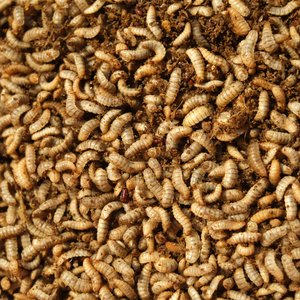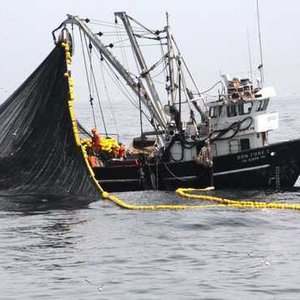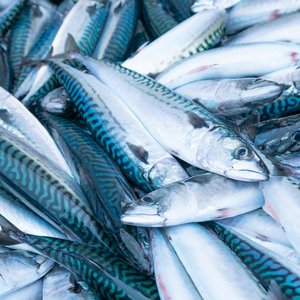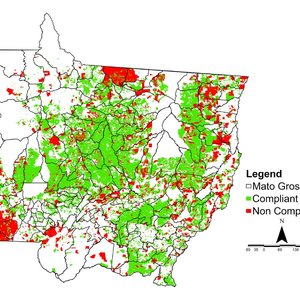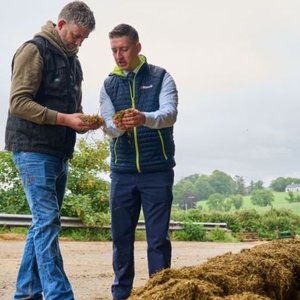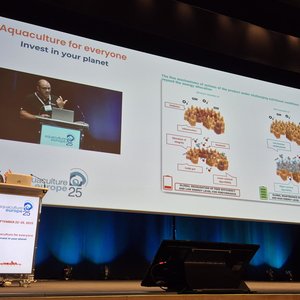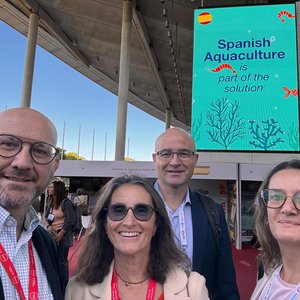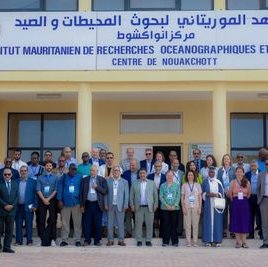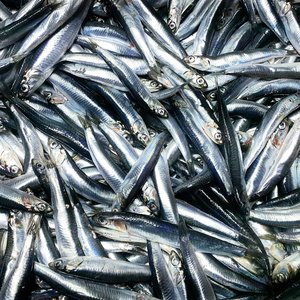By Marianne Nergård, a veterinarian specializing in fish health at Aker QRILL company
Winter is a challenging period for farmed salmon, as cold temperatures significantly impact their metabolism, causing all physiological processes to slow down. This slowdown affects processes like digestion, immune responses, and the recovery time of the skin and mucosal layers following procedures that compromise their integrity. Consequently, fish health is particularly vulnerable during this time. Recently, another critical physiological process linked to reduced fish robustness in winter has been identified—not only does their eating slow down, but their drinking does as well.
The role of fluid balance in maintaining fish health
The seawater surrounding salmon is much saltier than the fluid inside their bodies. The skin acts as a barrier to prevent dehydration, which occurs when water is drawn out of the fish into the surrounding environment through a process called osmosis. Despite this barrier, some water is lost, and salmon have developed strategies to maintain a healthy fluid balance between their bodies and the sea. One of these strategies is drinking. Salmon continuously drink seawater and excrete excess salts through their kidneys, gills, and secretions along the gastrointestinal tract.
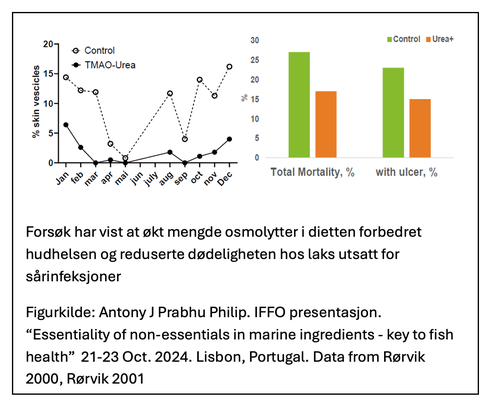
However, drinking slows down during winter, so the fish rely on another strategy to maintain fluid balance: increasing the levels of osmolytes in their bodies. Osmolytes help regulate fluid exchange, and one particularly potent osmolyte is Trimethylamine-N-oxide, commonly known as TMAO. This molecule not only helps salmon maintain fluid balance but also protects them from protein denaturation during pressure changes as they move up and down the water column, making it a vital adaptation for marine species.
TMAO has previously been linked to fish health. In 2000, Rørvik and collaborators published trials investigating the effects of TMAO and urea supplementation in feed on improving skin health and reducing ulcers in rainbow trout. In the study, they also observed reduced fat belching and improved lipid digestibility. The positive observations on the digestive system have further been supported in a recent study by Bockus and collaborators exploring the effects of TMAO supplements in rainbow trout. Growing evidence now highlights TMAO as a vital component in marine ingredients that supports fish robustness, particularly under challenging conditions such as cold waters. One increasingly discussed hypothesis is that osmolytes, especially TMAO, protect fish from dehydration, thereby strengthening their barriers and enhancing overall robustness.
Increasing focus on the role of osmolytes in marine raw materials
The importance of previously unrecognized beneficial components in marine ingredients was highlighted during a talk at the IFFO conference in October last year. Senior researcher Antony J Prabhu Philip from the Norwegian research institute NOFIMA presented a comprehensive summary of the current knowledge on osmolytes and their significance in fish feed.
“Although classified as non-essential nutrients, we need to acknowledge the essential role of osmolytes in feed and as a key source of marine ingredients. With 62.8 million salmon dying at sea in 2023 (16.7%), mostly from diseases, wounds, and osmoregulatory dysfunction should not be overlooked as we work to improve fish welfare,” said Antony J Prabhu Philip at IFFO Conference 2024.
It is known that when marine ingredients have been replaced with novel, often plant-based ingredients, the reduction of certain nutrients in marine ingredients may have affected fish health negatively. The omega-3 fatty acids, EPA and DHA, are the most well-known and studied examples, but it is evident that there might be more secrets in the marine ingredients in the form of components that are valuable and not yet investigated. Antony Philip and collaborators are investigating this in a research project “OsmoProtect” funded by the Research Council of Norway focusing on the role of osmolytes including TMAO, in supporting fish health through challenging periods. Aker QRILL Company is excited to follow the research, which has the potential to uncover a new range of essential nutrients in marine ingredients.
Krill is a rich source of TMAO
Krill are particularly reliant on TMAO due to their rapid daily migrations between deep and shallow waters, driven by light. During the day, they remain in deep, dark waters to avoid predators, and at night, they ascend to shallower waters to feed on algae that are more abundant near the surface. TMAO protects krill from damage caused by pressure changes as they move through different ocean layers.
In krill, TMAO has long been recognized as one of the compounds contributing to its attractant effect. Krill meal contains a significant amount of TMAO because the concentration is naturally high in live krill. The meal is produced by processing the whole krill immediately after capture, with careful handling of the raw material ensuring that the krill's nutritional composition, including TMAO, is preserved. This preservation extends to the point where the meal is delivered to feed producers and incorporated into fish feeds.
There is extensive documentation that krill supports fish health and robustness. Krill is a natural part of the salmon diet in the wild and is rich in nutrients known to enhance fish health, like EPA and DHA, antioxidants, vitamins and minerals. With the increasing knowledge around osmolytes, it is increasingly plausible that TMAO contributes to the health benefits provided by krill, particularly under challenging conditions.
Knowledge is the key to success with new raw materials
As the aquaculture industry continues to grow, it is crucial to be able to develop and utilize more raw materials that provide beneficial nutrients for fish feed. Krill is rich in many of the nutrients that fish need to stay healthy, and including krill in the diets may also enable the use of other novel ingredients that might not be as palatable or lack the complete nutrient profile required to fully support fish health and growth. Increasing the knowledge of what salmon requires to stay healthy means increasing the chances of successfully introducing new raw materials into aquafeeds.
References:
- Bockus, A. B., Powell, M. S., Sealey, W. M., Zito, P., Kurerov, Y., Sbisa, T., Carrillo-Longoria, J. A., & Gaylord, T. G. Dietary trimethylamine oxide alters digestibility, intestinal histopathology, and gene expression in soy fed rainbow trout (Oncorhynchus mykiss). Aquaculture, 596, 741810 (2025). https://doi.org/10.1016/j.aquaculture.2024.741810
- Rørvik, Steien, Nordrum, Lein, and Thomassen. Urea in feeds for sea water farmed Atlantic salmon: effect on growth, carcass quality and outbreaks of winter ulcer. Aquaculture Nutrition, 7: 133-139 (2001). https://doi.org/10.1046/j.1365-2095.2001.00173.x
- Carroll, S., Kelsall, C., Hazon, N. and Eddy, F.B. Effect of temperature on the drinking rates of two species of flatfish, flounder and turbot. Journal of Fish Biology, 44: 1097-1099 (1994). https://doi.org/10.1111/j.1095-8649.1994.tb01280.x
- Gaten, E., Tarling, G., Dowse, H. et al. Is vertical migration in Antarctic krill (Euphausia superba) influenced by an underlying circadian rhythm? J Genet 87, 473–483 (2008). https://doi.org/10.1007/s12041-008-0070-y




